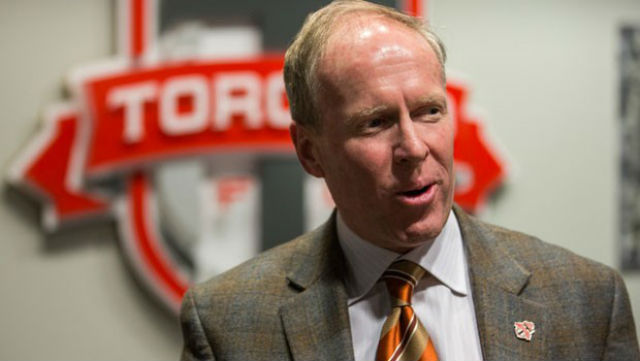Payne looks to shake up U.S. development

Kevin Payne has ideas.
In reality, Payne’s always had ideas from hard-won truths learned on the ground level of soccer’s rise in America. After more than two decades at the executive level with U.S. Soccer, MLS and AEG, Payne was privy to the gritty truth about development in America. Namely that it wasn’t up to the standard set by the world’s leading soccer nations. And so while those ideas germinated, Payne didn’t have much of an outlet to release them into the wild.
That changed this year. In September, 2013, Payne left his job as the GM and president of Toronto FC after less than two years without a clear path forward. After nearly 20 uninterrupted years in MLS front offices with TFC and D.C. United, Payne wasn’t quite sure where to go next.
“At that point I wasn’t doing much of anything,” Payne said. “I had a lot of people calling me and talking to me about doing stuff. I hadn’t even formed a company yet. I left Toronto at the end of September, and I was really taking some time off to figure out what I wanted to do next. I knew I wanted to still do something that would forward the game. That’s always been my primary motivation. I wasn’t thinking about this, I can tell you that.”
This, in this case, began with a meeting with longtime US Club Soccer staffer Ken Chartier in a Philadelphia hotel during the 2014 NSCAA Convention. Chartier wondered if Payne, a lifelong ideas man, would ever consider running US Club Soccer? Payne thoughtfully considered before his uncertain answer cut through the conversation
“I said, ‘I don’t really know the answer to that question,’” Payne said.
They two agreed Payne would assume a consulting role beginning last March to better understand the inner-workings of the organization. Less than a year later, Payne strolled into US Club Soccer’s Charleston, South Carolina home office as its newest CEO in January.
Payne will oversee US Club Soccer’s raft of properties, including its National Premier Leagues and id2 program. The former is US Club Soccer’s answer to the Development Academy, while the latter provides a pipeline to identify players for U.S. Soccer’s U14 Boys National Team. The id2 program has become arguably US Club Soccer’s most enduring legacy since the organization began 13 years ago, as the current U.S. youth national team setup is dotted with players who were initially identified in the program.
Payne’s ideas stretch from the organizational level to the ground floor of how players are identified and coached. During his consultation period with US Club Soccer, which lasted about nine months, Payne was heartened by the organization’s mobility. If he wants to enact policy on the executive level, the amount of translation that needs to funnel to the club level is minimal. Further, he hopes to bridge the gap that’s emerged between certain youth organizations sharing overlapping spheres of influence.
“I don’t look at this as a zero-sum game,” Payne said. “We’re not intent on world conquest at the expense of other organizations in the youth space. I hope all of them do well. I don’t think our success and USYS’s success, for instance, are mutually exclusive. I think too much energy has been spent on that over the years. That doesn’t have anything to do with improving the game or the experience. That’s just a political game that gets played. I want to get us away from that.”
As for next steps, many of Payne’s ideas orbit around improving the level of coaching on a club level. Since the organization’s setup doesn’t include meddlesome layers of red tape, Payne feels as though implementing avenues that lead to various higher level coaching education are within the organization’s grasp. While U.S. Soccer handles the vast majority of the specific licensing, Payne’s kicked around the idea of engaging with foreign clubs with demonstrable development expertise, and then opening up a marketplace for those clubs to market their coaching knowledge to US Club Soccer clubs and coaches.
“We think there’s a role for us to play in creating that bridge,” Payne said.
Payne also says he wants to improve and expand the id2 program by bringing “more kids under the tent, at least at the beginning.” Arguably US Club Soccer’s most important program, Payne wants the scouting system to cast a wider net for players invited to the club’s various regional camps. That could mean expanding both the number and geographic scope of of those camps to reel in an increasing number of quality players.
On a macro level, Payne feels as though US Club Soccer can help bridge the developmental gaps that exist in the current youth space. If it hasn’t been good enough so far, Payne hopes US Club Soccer under his stewardship can make inroads to cleaner air.
“What we’ve done in this country to develop players has not been good enough,” Payne said. “That’s not an indictment of anyone in particular, but we have to begin the process of improving by admitting that we’re not good enough. I think we’ve been a little reluctant to do that. We recognize that there’s vast room for improvement, and what we want to do with US Club Soccer, we want to be known as the organization that provides clubs a really comprehensive suite of resources to improve in every way.”
Headlines
- Recruiting Roundup: May 5-11
- 2025 Women's Division I Transfer Tracker
- How Do I Get Scouted by TopDrawerSoccer?
-
ECNL Boys NC U14 Players to Watch

-
Women's Big South Breakout Candidates

-
MLS NEXT Flex: Under-15 Players to Watch

- NL Semifinals in Cali Wraps After Five Days
-
ECNL Girls SC U14 & U15 Players to Watch

-
Women's Big East Breakout Candidates

-
Club Soccer Standouts: May 3-4




